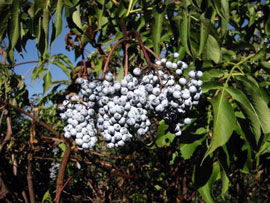The iconic Quercus garryana, also known as Garry oak and Oregon white oak, is a drought tolerant tree that can also tolerate prolonged seasonal flooding. It can often grow on sites that are too dry for other tree species. These slow-growing trees are smaller at maturity than many Pacific Northwest trees, growing eventually to a maximum size of 65-80 ft tall and wide. They have deep tap roots and widely spreading roots, making them resistant to wind-throw. Mature trees growing in open areas develop broad oval crowns, making them excellent shade trees.
The leaves are deciduous, 3-6″ long and 2-5″ broad, with 7-9 deep lobes on each side. The flowers are catkins, and the fruits are small acorns about 1″ long with shallow, scaly cups.
Over 200 species of wildlife benefit from Oregon white oaks, including pollinators such as Fender’s blue, Taylor’s checkerspot, Mardon skipper, Islad marble, and the Oregon silverspot. The Oregon white oak is also the only known food for the caterpillars of Propertius duskywing butterflies and a leaf-mining moth. Deer, bear, raccoons, squirrels, and many small mammals eat the acorns, as do wild turkeys, band-tailed pigeons, woodpeckers, jays, and others.
Oregon white oaks also have significant cultural value for many Native tribes. For all these reasons, Oregon white oaks and their associated prairie habitats are the focus of many regional conservation efforts.
- Oregon white oak (Quercus garryana) has thick, fire-resistant bark. Younger trees are more vulnerable.

Blue Elderberry
Blue elderberry (Sambucus cerulea) is a large, fast-growing deciduous shrub or small tree featuring showy clusters of creamy-white flowers that mature into large clusters of blue-black berries.
This shrub is a great addition to your wildlife garden. Many birds eat the berries, and butterflies visit the flowers for nectar. The plant provides food for the young of spring azure butterflies and various moths. Native solitary bees shelter and lay their eggs in the hollow twigs. Dead elder wood is also the preferred habitat of the mushroom Auricularia auricula-judae, also known as Judas’ ear fungus or wood ear fungus.
Blue elderberry can get quite tall, reaching up to 15 feet in height. Plant it in sun to part shade in well drained soils.



